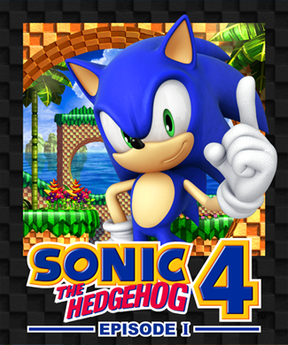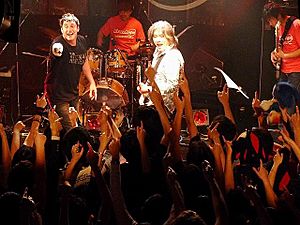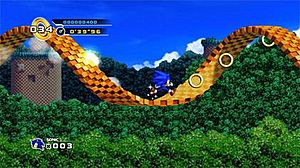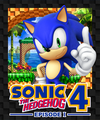Sonic the Hedgehog 4: Episode I facts for kids
Quick facts for kids Sonic the Hedgehog 4: Episode I |
|
|---|---|
 |
|
| Developer(s) |
|
| Publisher(s) | Sega |
| Director(s) | Toshiyuki Nagahara |
| Producer(s) |
|
| Designer(s) | Yukihiro Higashi |
| Programmer(s) | Katsuya Kuramoto |
| Artist(s) |
|
| Composer(s) | Jun Senoue |
| Series | Sonic the Hedgehog |
| Platform(s) | iOS, Wii, PlayStation 3, Xbox 360, Windows, Windows Phone, Android, BlackBerry Tablet OS |
| Release date(s) |
October 7, 2010
iOS
|
| Genre(s) | Platform |
| Mode(s) | Single-player |
Sonic the Hedgehog 4: Episode I is an exciting platform game released in 2010. It was made by Dimps with help from Sonic Team and published by Sega. This game is a direct follow-up to Sonic & Knuckles from 1994.
In Episode I, players join Sonic on a new adventure. His goal is to stop the evil Doctor Eggman, who has returned. The game plays like the classic Sonic the Hedgehog games from the Sega Genesis. You move from side to side in a 2D plane, racing through levels. Sonic collects rings and attacks enemies by rolling into a ball.
The game also has special levels where you can collect Chaos Emeralds. There are online leaderboards too, so you can compare your scores and times with other players. Development for Sonic 4 started in May 2009 and took about a year and a half. It was first planned for smartphones but became a big game for many different systems.
Episode I was designed to feel like the old Genesis Sonic games. It has simple controls and no voice acting. The levels focus on jumping and using speed. Only Sonic is a playable character. However, Sonic's look and moves are from newer games like Sonic Adventure (1998). The creators wanted to please both old and new Sonic fans.
The game was released in October 2010 as a downloadable game. It came out for iOS, PlayStation 3, Wii, and Xbox 360. Later, it was released for Windows Phone, Windows, Android, and BlackBerry Tablet OS. Episode I got good reviews and sold over a million copies in its first year. Many critics liked that it felt like a return to classic Sonic games. Some people thought the game's physics engine wasn't as good as the old games, and it was a bit short. Episode I was meant to be the first part of three games. Episode II came out in 2012, but Episode III was never made.
Contents
How to Play Sonic the Hedgehog 4: Episode I
Sonic the Hedgehog 4: Episode I is a side-scrolling platform game. It looks and plays a lot like the Sonic the Hedgehog games from the 1990s on the Sega Genesis. The story starts right after the events of Sonic & Knuckles (1994). Sonic the Hedgehog decides to explore new places on his own, leaving his friends Miles "Tails" Prower and Knuckles the Echidna behind.
But then, Doctor Eggman shows up again! He survived his last defeat and has made his old robots even better. Eggman plans to get rid of Sonic once and for all. The game uses a 2.5D view. This means characters and objects look 3D, but you can only move left or right, like in a 2D game.
Sonic is the only character you can play in this single-player game. You can move him left or right to build up speed, jump, and roll into a ball to attack enemy robots. Sonic can also do a "homing attack." This move, from later 3D Sonic games, lets him target and dash into robots or objects while in the air. Sometimes, using homing attacks one after another can open up new paths in the levels.
Exploring the Game's Zones and Levels
The game has four main levels, called zones. Each zone is split into three smaller parts, called acts. Unlike the old Genesis Sonic games, once you finish the first act, you can choose which zone to play next from a world map.
The levels are inspired by places from the first Sonic the Hedgehog (1991) and Sonic the Hedgehog 2 (1992). You'll see familiar things like slopes, deep pits, loops, corkscrews, and springs. There are also power-ups like shields, invincibility, and speed shoes. Some levels have special features, such as vines to swing on or pinball flippers and bumpers.
After you complete all the acts in a zone, you'll face a boss battle against Eggman. He flies around in one of his robots, and you need to hit him eight times to win. Once you finish all four zones, a fifth and final level unlocks.
Collecting Rings and Special Stages
Like other Sonic games, you collect rings to stay safe. If you have at least one ring and get hit by an enemy, you'll survive, but your rings will scatter. They blink for a short time before disappearing. If you get hit with no rings, fall into a pit, or drown, you lose a life. If you lose all your lives, it's game over.
If you finish an act with 50 or more rings, you get to enter a special stage. The special stages in Episode I are like the ones from the first Sonic the Hedgehog game. Sonic is curled into a ball and bounces off bumpers and walls in a spinning maze. You need to tilt the maze to guide Sonic through it within a time limit. Collect rings to open gates and find time bonuses.
Finishing a special stage gives you one of the seven Chaos Emeralds. If you collect all seven, Sonic can turn into Super Sonic! This makes him invincible and super fast, but it uses up one ring per second. Collecting all the Chaos Emeralds also shows a short scene after the credits. It teases Metal Sonic, hinting at what happens in Sonic the Hedgehog 4: Episode II (2012). You can also upload your game scores to online leaderboards to see how you compare to other players.
Game Versions and Controls
Each version of the game is mostly the same, but there are some small differences in screen size and how clear the picture is. For example, the PlayStation 3, Xbox 360, and Windows versions support HD and widescreen screens. The Wii version does not.
The PlayStation 3 and Wii versions also let you use their special motion controllers. The mobile versions can be played using the device's accelerometer (by tilting the device) or by using virtual buttons on the touchscreen. Two levels in the mobile versions were designed specifically for tilting the device.
Making of Sonic the Hedgehog 4
The idea for Sonic 4 came about in January 2009. Development started four months later and took about a year and a half. Dimps, a company that had made other Sonic games for the Game Boy Advance and Nintendo DS, led the creation of the game. Sonic Team also helped out. Toshiyuki Nagahara from Sonic Team was the director.
Only two people on the team had worked on the original Genesis Sonic games: producer Takashi Iizuka and composer Jun Senoue. The game was first announced on September 11, 2009, with the name Project Needlemouse. Its real title, Sonic the Hedgehog 4: Episode I, was revealed on February 4, 2010, along with the first video of the game.
Why Sega Made Sonic 4
Brand manager Ken Balough said that Sonic 4 was made because fans kept asking for a return to the classic Sonic gameplay. He knew that some Sonic fans loved the old Genesis games, while younger fans enjoyed newer games like Sonic Unleashed (2008). Sega wanted to make a game that both groups would like.
Balough told Nintendo Life that making a 2D Sonic game just felt right for Sonic 4. He said it was a game fans had wanted for years, and they felt they had the right team to make it. While Balough said it was always called Sonic 4, some reports suggest it was first planned as a smartphone-only game called Sonic the Portable. It was later renamed Sonic 4 and released on many systems. You can even see signs in one level that still say Sonic the Portable!
Bringing Back the Classic Feel
Iizuka explained that after Sonic Adventure came out in 1998, Sonic games focused more on speed. But he also knew many fans still loved the Genesis games. With Sonic 4, Iizuka wanted to bring back that classic Sonic style using modern technology. To keep it true to the original games, the creators decided not to include voice acting.
The team started by focusing on what they thought was most important for a Sonic game: simple controls (one button for jumping and attacking) and levels that focused on platforming and using momentum. To make Episode I feel like a true follow-up to the Genesis games, they brought back familiar level locations. Iizuka said this was to "tap into that nostalgia factor" and make people feel it was a continuation of the Genesis era.
Most of the game's content is the same across all versions. However, two levels in the mobile version were changed for the console releases. These levels were designed for smartphone gyroscopes, and the team felt they didn't work well on consoles.
New Moves and Characters
One new move added to the game was Sonic's homing attack from Sonic Adventure. Iizuka said the team wanted to add the excitement of doing continuous attacks. They felt it "add[ed] to the classic-style gameplay by providing a new means to discover routes in the sky."
Even though Sonic the Hedgehog 4: Episode I returned to the classic style, Sonic himself uses his design from after Sonic Adventure. Iizuka explained this was because the game wasn't a remake. When the project was announced, Sega started a countdown in January 2010. They listed possible playable characters and removed them as fans answered trivia questions. This ended with the reveal that Sonic would be the only playable character. Iizuka said this choice was made so both old and new fans could enjoy the game. Limiting the many characters was also a way to go back to the series' roots.
Despite this, the scene after the credits hints at the return of Metal Sonic. He hadn't been in a Sonic game for years. Balough said fans had been asking Sega to bring Metal Sonic back, and the post-credits scene was added to keep players excited for Episode II.

Creating the Music
Jun Senoue only composed a few songs for the Genesis Sonic games. But for Sonic 4, he was in charge of all the music and sound effects. The music was made to sound like the Genesis Sonic games. Balough said this was because the creators wanted the game to feel "like a genuine extension of the first three Sonic games."
Senoue was involved early on when Iizuka asked him to compose. Senoue tried to make the songs as if he were composing them for the Genesis, using as few notes as possible. He didn't use any special old sound equipment, though he did try to find an old Genesis development kit without success. Senoue tried to make songs "with a similar beat or similar tempo" to those from Sonic the Hedgehog and Sonic the Hedgehog 2. Senoue enjoyed working on Episode I. He said his favorite song was for the first level, even though Nagahara didn't like it and tried to get him to change it. Eggman's theme music was actually an unused song from Sonic 3D Blast (1996).
Release and Updates
Episode I was first planned to be released in July 2010. Sega announced this in February 2010. Months before the game came out, an early version was accidentally made available to users of Xbox 360's game testing service, PartnerNet. Pictures and videos of the game were leaked online, and PartnerNet had to be temporarily shut down.
Even though some game journalists liked the leaked materials, fans reacted negatively. In May 2010, Sega announced that Episode I would be delayed until late 2010. This was because of feedback from both inside the company and from fans. Iizuka later said the delay was so developers could replace the mobile-only levels with ones better for consoles.
When Sonic 4 Came Out
Episode I was released on October 7, 2010, for iOS devices. Other versions followed soon after:
- The Wii version came out on WiiWare in North America on October 11 and in Europe on October 15.
- The PlayStation 3 version was released on PlayStation Network in North America on October 12 and in Europe on October 13.
- The Xbox 360 version was released on Xbox Live Arcade on October 13.
Later releases included:
- A Windows Phone version on June 15, 2011.
- A Windows version on Steam on January 19, 2012.
- An Android version on January 25, 2012.
- A BlackBerry Tablet OS version on July 20, 2012.
- Both Episode I and Episode II were also released for the Android-powered Ouya on July 9, 2013.
Recent Updates
In April 2016, the iOS version got its first update in three years. This update made it work better on newer devices. Changes included support for widescreen and Retina displays, more detailed character models, and improved textures. The iOS version used to have separate apps for iPhone and iPad. The update stopped the iPad version and made the iPhone one a "universal" app, meaning it works on all iOS devices.
Later in 2016, the Xbox 360 versions of Episode I and Episode II were added to the Xbox One's list of backward compatible games. This means you can play them on an Xbox One console.
The Future of Sonic 4
Episode I was planned to be the first part of a series of three games. Before Episode I was released, Balough confirmed that Sega had planned the whole Sonic 4 story. He didn't say how many episodes there would be, but he mentioned they would "definitely make up a larger game." He said that after finishing them all, players would experience a bigger story that felt as epic as earlier Sonic games.
In August 2011, Iizuka stated that Episode II would not be released until 2012. This was more than a year after Episode I, because Sonic Team wanted to focus on Sonic Generations first. Before Episode II came out, Sega re-released Sonic CD (1993) for modern consoles. They even advertised it as a prequel to Sonic 4.
Sonic the Hedgehog 4: Episode II
Episode II was released in May 2012. This game brought back Tails and Metal Sonic. The story follows Sonic and Tails as they try to stop Eggman and Metal Sonic from launching the Death Egg again. Fan feedback from Episode I was very important for making Episode II. The creators worked to fix things that fans didn't like, such as the physics engine.
Episode II was released on most of the same platforms as Episode I. However, the Wii version was canceled because of technical limits of the console. Players who own both episodes on the same system can unlock a special feature: they can play as Metal Sonic in Episode I's levels!
Why There Was No Episode III
In March 2012, Iizuka announced that Sega did not plan to continue Sonic 4 beyond Episode II. In 2015, an Australian game developer named Christian Whitehead said he was offered the chance to make Episode III with Sega Studios Australia. But that division was shut down. Instead, he worked on updated versions of Sonic the Hedgehog and Sonic the Hedgehog 2 between 2012 and 2013.
Whitehead said that while it was possible Episode III could be made someday, it was unlikely. Whitehead later led the creation of Sonic Mania (2017). Like Sonic 4, Sonic Mania also acts as a sequel to the Genesis Sonic games. Sonic 4 and Sonic Mania are often compared, but many journalists felt Sonic Mania was a much better game than Sonic 4.
Images for kids
See also
 In Spanish: Sonic the Hedgehog 4 para niños
In Spanish: Sonic the Hedgehog 4 para niños



